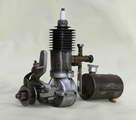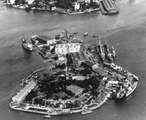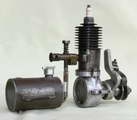The 10cc Garden Island Special
 |
 |
 |
Click on images to view larger picture.
This is an Australian copy of the very successful Brown Jnr. It was made during World War Two by a Mr Louis (Lou) Taylor. During that period, Mr Taylor worked in the machine shop on Garden Island, a very important naval repair installation located in Sydney Harbour,
One wonders how he had the time to build model engines during this critical period in world history, yet there are parallels elsewhere in the world—Ogawa built engines in Japan during the war, STAB engines were made in Paris during the occupation and it now appears engine-building and even powered model flying was not unknown in other European countries at this time. The Nova-1 was published for home construction during the occupation of Holland, and Kratsch and Eisfeld were sanctioned constructors in Nazi Germany; their engines being distributed to the Hitler Youth movement. As far as we know, there was certainly no commercial manufacture of model engines in Great Britain during those dark years.
To return to the Taylor engine, the question does arise as to whether a limited production was envisaged. The crankcase is an excellent gravity-die casting, the exhaust ports have been punched in the steel cylinder by expertly handled, shaped punches and the integral cylinder finning is machined to a very nice, tapered profile with a rounded root. Unlike the threaded Brown, the cylinder is fixed to the alloy case with two screws, obviating any possible problems with alignment.
A lapped, cast-iron piston is used, coupled to a fully machined and bushed alloy conrod. The hardened and ground steel crankshaft runs in a very well-fitted bronze bush. Though the engine appears to have had a fair bit of running and certainly has been mounted in a model, there is very little sign of wear in the working parts.
Everything is finished in a most workmanlike manner, with particular attention to the NVA and venturi assembly. The latter has a split clamp, which fixes it in any position to the inlet stub brazed onto the cylinder. This clamping arrangement is common to many early British and European engines and in direct contrast to the American Brown Jnr, though both designs carry a rotating choking sleeve.
The large tinplate tank, which has lugs to mount on the plane's engine bearers, appears to have been originally located directly under the spraybar and soldered to it. As received, the inlet hole for this has been soldered over and replaced with a pick-up tube in one endplate.
The contact breaker assembly features a moving point from some contemporary full-size engine. The timer casting, whilst perfectly sound and workmanlike, is nonetheless bulky and out of keeping with the neatness of the rest of the engine.
The writer was introduced to Mr Taylor, who it was said still had the die and tooling for the engine. However, by this time he appeared to be in a state of dementia and claimed no knowledge of the engine at one point in the conversation!
David Owen, March 2011